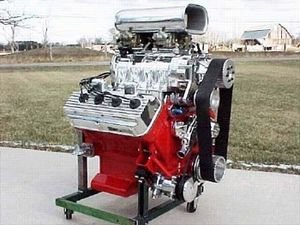.
392 HEMI engine

| |
| 392 HEMI | |
|---|---|
| Engine | |
| Manufacturer | Chrysler |
| aka | Type aka here, not up there |
| Type | Gasoline (Petrol) |
| Production/Introduction | produced/introduced from when to when |
| Status | Discontinued |
| Displacement | 392 cu-in. |
| Aspiration | naturally aspirated |
| Configuration | V |
| Cylinders | 8 |
| Fuel System | 4V Carburetor |
| Lubrification | indicate the engine's type of lubrification |
| Output | 345 hp @ 4600 rpm 450 lb-ft. of torque @ 2800 rpm |
| Bore | 4.0000 in |
| Stroke | 3.906 in |
| Compression | 10.0:1 |
| In. Valves | 2.00 in |
| Ex. Valves | 1.75 in |
| Firing Order | 1-8-4-3-6-5-7-2 |
| Left Bank | 1-3-5-7 |
| Right Bank | 2-4-6-8 |
| Length | in inches |
| Diameter | in inches |
| Width | in inches |
| Height | in inches |
| Dry Weight | 767 lb |
| Fuel Consumption | city/highway (mpg & km/L) |
| Emission/s | CO: g/km CO2: g/km NOx: g/km Hydrocarbon: g/km Particulate: g/km |
| Chief Engineer | write here |
The original 392 HEMI engine was introduced in the new 1957 model year Chryslers and Imperials. It replaced the 354 cubic-inch version of the original HEMI launched in 1951.
Compared with the 354, the 392 was completely revised and improved, with larger valves and ports, a beefier block and crankshaft, and improved bearings. In short, the 392 HEMI, often referred to simply as the “92,” was perfect for drag racing.
More than a few racers bolted on six or eight carburetors, slipped in a hotter cam, tipped some nitro into the tank and went racing. Racing legend Don Garlits ran a 392 in his Swamp Rat I at record speeds of over 180 mph on nitro with no supercharger. Garlits also used a 392 HEMI to officially break the 200-mph barrier when his Swamp Rat went 201.34 mph at Atco, N.J. in 1964.
Photos
Unique Attributes
Criticisms
Biggest complaint- there's nothing to put them into.
There's no standard chassis to bolt a 392 Hemi into and actually drive on the street, except for the huge land yachts it came in originally in 1957-58. These engines look out of place in a 1960-70's musclecar. They look good in a 1930's-early 50's street rod, rat rod, or dragster/rail.
It makes no sense to put a 392 Hemi in a Challenger or Roadrunner, they just don't look right in the car, and a 440 would run better and make more power.
Worldwide
If the vehicle is sold in other markets worldwide, then this is the section to mention that information. Also, mention if the <MODEL> goes by another name in these other markets.
Design quirks and oddities
Refer to any pop-culture tidbits about the vehicle in this section.
Awards
List out notable awards that the model has recieved while in production. Boldface the company or orgainization that gives out the award, and Italicize the name of the award.
See Also
| image (between 170-190 pixels) | ||
| HEMI | ||
|
Chrysler | Dodge | Jeep | Plymouth | DeSoto | GEM Current HEMIs: 345 cid (5.7 liter) · 370 cid (6.1 liter) · 392 cid (6.4 liter) Historic HEMIs: 241 cid · 259 cid · 270 cid · 276 cid · 291 cid · 315 cid · 315 cid · 330 cid · 331 cid · 341 cid · 354 cid · 392 cid · 426 cid · 472 cid · 528 cid Racing HEMIs: | ||
| Chrysler | Corporate website | An engine owned Chrysler LLC |
External Links
Please include any external sites that were used in collaborating this data, including manufacturer sites, in this section.
